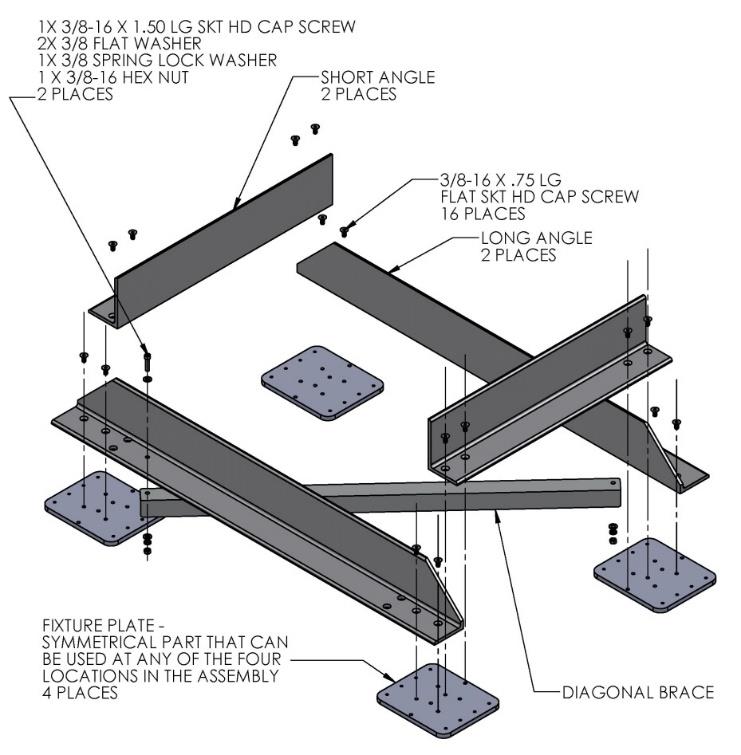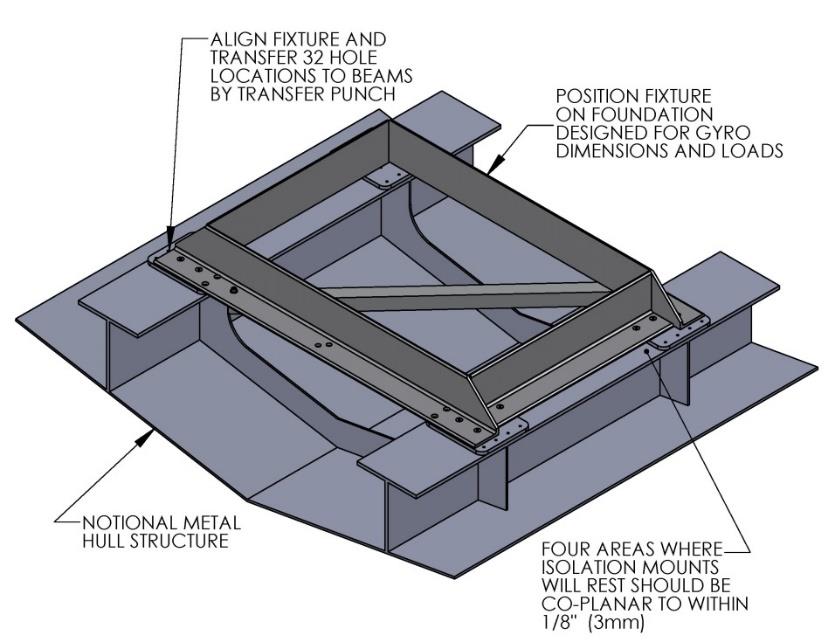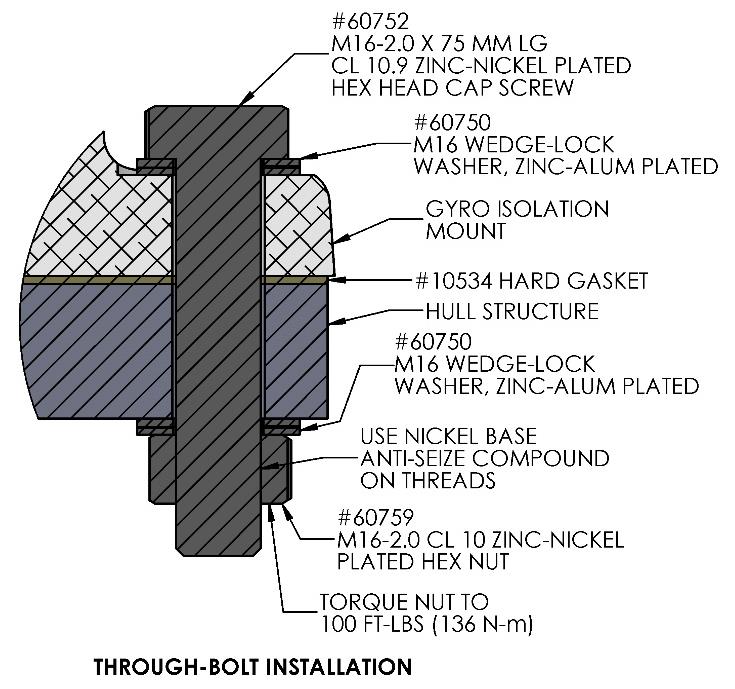Seakeeper 26 Installation Manual (90265-8); S/N 26-233-0690 to Current
2.4 Bolt-In Installation
2.4.1 Preparation of Vessel Structure
Seakeeper provided mounting hardware is intended to apply to typical installation arrangements. However, each installation, especially custom aftermarket foundations, should be thoroughly reviewed to ensure the provided hardware meets the required thread engagement for the Seakeeper unit being installed. The mounting bolt thread engagement requirements are outlined in the Installation Manuals and Installation Details Drawings for each Seakeeper model. This also applies to Seakeeper model adapter kits and OEM built frames where the bolt hole depth should be checked to ensure the bolts will not bottom, preventing the bolts from achieving the intended preload.
When the Seakeeper provided hardware is not appropriate, the bolt specification (diameter and thread pitch) and grade should be matched in the required length and used with the Seakeeper provided washers. Mounting bolts should always be torqued to the Seakeeper specification. All Seakeeper provided bolts are metric course thread. Hardware specifications are also listed in the Installation Manuals and Installation Details Drawings.
Refer to Seakeeper Drawing No. 90271 – Seakeeper 26 Bolt-In Installation Details. Important dimensional and load information is given in this drawing that will impact the design details of the structure that will receive the Seakeeper. It is assumed that a proper structural analysis has been performed for the hull structure to which the Seakeeper will be fastened to ensure proper strength margins for the loads the Seakeeper will create during operation. Seakeeper recommends a safety factor of 3.0.
Two bolt-in kits are available
1) Through-Bolt, reference Drawing No. 90086 – Seakeeper 26 Bolt-In Installation Kit, M16, Through-Bolt
2) Blind-Hole, reference Drawing No. 90614 – Seakeeper 26 Bolt-In Installation Kit, M16, Blind-Hole
The hull structure supporting the Seakeeper should be arranged so the Seakeeper is parallel to the water plane in the port-starboard and forward-aft directions . In addition, the four areas on top of the beams on which the feet of the isolation mounts will rest, need to be co-planar within 1/8 in. (3 mm) to minimize potential distortion of Seakeeper support frame when installed.
Seakeeper provides an installation fixture assembly (P/N 90089), which contains four plates that mimic the mating surfaces of the four isolation mounts located on the Seakeeper’s foundation. These plates have 8 holes located at the same centers as the holes in the isolation mounts. These smaller holes can be used to locate the holes in the ship’s structure through use of a transfer punch. The fixture locates the hole patterns at the proper spacing, both in the fore-aft direction and the port-starboard direction. See Figures 2 & 3 below. Once assembled, the fixture can be used to check clearances and alignment of the hull structure.
Note: Do NOT use the installation fixture to establish Seakeeper envelope dimensions. Refer to Drawing No. 90271 – Seakeeper 26 Bolt-In Installation Details, for envelope dimensions. A 3-D model of the Seakeeper is available on the Seakeeper website (www.seakeeper.com) to aid in designing the Seakeeper foundation and the space around the Seakeeper.


2.4.2 Transfer of Holes to Boat Structure
- Lower assembled fixture onto hull structure.
- The four areas where the isolation mounts will rest should be coplanar to within 1/8 in. (3 mm). See figure below. Do not use the fixture to check co-planarity as it is not stiff enough.
- Align fixture in desired location and transfer holes from fixture plate to the hull structure. A transfer punch is recommended for this step. Note that holes in fixture plate are ø.257 in. (6.5 mm).
- Remove fixture and drill holes in foundation at marked locations to mate with holes in Seakeeper isolation mounts. A ø.689 in. (17.5 mm) hole is recommended for through-bolt installations.
NOTE: Certain foundation designs that employ threaded blind holes in thick plates may require the installer to obtain alternate fasteners. Reference Drawing No. 90614 – Seakeeper 26 Bolt-In Installation Kit, M16, Blind-Hole.


2.4.3 Installation of Seakeeper
- Locate and position 4 isolation gaskets onto foundation beams (for metal to metal contacts only).
NOTE: A VERY SMALL AMOUNT OF SEALANT MAY BE APPLIED TO THE GASKET TO KEEP WATER FROM WICKING INTO THE JOINT. Isolation gaskets are only required when mounting to a structure other than aluminum or GRP. - Lower Seakeeper into position onto foundation beams and align over drilled holes.
- Install Mounting Bolts:
- For Through-Hole installation (P/N 90086 – Seakeeper 26 Thru-Bolt Kit), install the Seakeeper supplied M16 fasteners as shown in figure below to maintain a minimum of two (2) threads protruding past nut. Apply a moderate coat of nickel-based anti-seize(e.g., SAF-T-EZE nickel grade anti-seize, SBT-4N or equivalent) to the threads of each bolt and include a small bead of marine grade sealant (e.g., SILI-THANE 803or equivalent) under each bolt head and washer before installation. See Figure 4 below.
- For Blind-Hole installations (P/N 90614 – Seakeeper 26 Bolt-In Kit), install the Seakeeper supplied M16 fasteners as shown in figure below to maintain a minimum thread engagement of 0.89 in. (23 mm). Apply a moderate coat of nickel-based anti-seize(e.g., SAF-T-EZE nickel grade anti-seize, SBT-4N or equivalent) to the threads of each bolt and include a small bead of marine grade sealant (e.g., SILI-THANE 803 or equivalent) under each bolt head and washer before installation. See Figure 5 below.
- Torque all fasteners to 100 ft-lbs (136 N-m).
- New bolts matching the Seakeeper specification must be used for each installation and reinstallation that meet the requirements listed above.
- Proceed to electrical and cooling portion of the installation.


